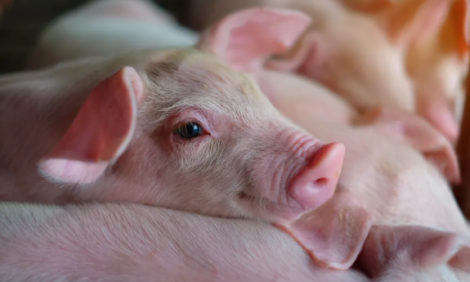



UK/EU Pig Market Update - November 2003
By the British Pig Executive - This BPEX report looks at the current market situation in the UK and reviews recent price trends and markets throughout Europe.Producer Prices
|
|
United Kingdom producer prices have continued to be underpinned by continuing supply shortages, seasonally stronger retail demand and processors buying for the Christmas market. The average UK price continued to increase in the first half of November, but at a lower rate. Prices moved downwards slightly in the week ended 22 November although the average price for the week, 107p, was still 1-2p higher than a month earlier and 17p more than in the corresponding week of 2002.
Weaner prices remained relatively stable during November, with prices of 30kg pigs continuing to average around £34.
|
Comparison of UK and EU Pigmeat Reference Prices

(a) Price based on EU dressing specification adjusted to cold carcase weight. These are gross prices before deductions for transport, etc. MLC estimates that the typical deduction in the UK is 4.5p/kg compared with an EU average of 2.6p.
|
The EU reference price edged slightly lower in November. In the week ended 23 November it was just one per cent less than a month earlier. Spanish prices rose five per cent on a month earlier, although they remain well down on mid-year. Prices also showed a partial recovery in France, where markets have been adversely affected by low-priced Spanish imports. Prices rose by three per cent but again they remain significantly lower than a few months ago. Danish prices were unchanged while there were further declines in Germany (-4%) and the Netherlands (-6%).
The Euro has continued to edge higher against the US dollar this year. This will have made export trading conditions more difficult and will have put some downwards pressure on EU prices. The Euro was worth 119 US cents in late November, 20 cents more than a year ago and around 30 cents more than two years ago.
With UK prices continuing to show small gains in November, the UK premium over the average EU price continued to increase. In the week ended 23 November it stood at 21p/kg, up from 18p a month earlier.
|
EU Pigmeat Prices

|
Slaughterings
Clean pig slaughter levels have been well below corresponding 2002 levels since January. This has arisen in part from a lower breeding herd but more importantly from poorer sow productivity. Defra slaughtering statistics for October indicate that UK throughputs averaged around 180,000 head, slightly down on the previous month, while preliminary MLC estimates for November indicate average weekly throughput at a similar level.
|
Estimated clean pig slaughter levels in November

|
A number of factors are likely to have contributed to lower productivity this year, including:
- Reports of some sporadic increases in PMWS incidence in the early part of 2003.
- Some disruptions to breeding patterns and performance arising from a significant number of producers depopulating and then repopulating last year.
- A developing sow infertility problem since last autumn, which affected clean pig slaughter levels in the April-June quarter.
Since the middle of the year there has been some recovery in productivity, as these factors have become less acute. But the extent of the recovery so far is likely to have been held back by increased mortality and poorer growth rates, arising from the hot summer weather.
From the middle of the year through to September there was some recovery in productivity, as these factors have become less acute. But the extent of the recovery so far is likely to have been held back by increased mortality and poorer growth rates, arising from the hot summer weather. October and November saw productivity stabilising, contrary to earlier expectations.
|
Estimated GB Sow Productivity Trends (a)

(a) Defined as monthly clean pig slaughter annulaised and divided by estimated breeding herd 7 months earlier. Ratio's are deseasonalised and smoothed. Adjustments made to take account of Swine Fever in 2000 and FMD in 2001
|
The hot summer weather is also likely to have a longer-term impact on the UK pig meat sector. The heat affected conception rates, which is likely to have a negative effect on slaughter levels in the spring of 2004.
Feed prices
Over the past few months feed prices, both cereals and proteins have increased rapidly. Feed wheat prices are currently at their highest level for seven years. So far the majority of pig producers have not been exposed to higher feed costs, as the common practice is to make feed purchase contracts several months in advance. However, over the course of the next few months an increasing number of producers will have to pay higher feed costs as their current contracts come to an end.
The current season has been marked by a very significant increase in feed prices, with both grain prices and protein prices showing major increases. The average price of feed wheat for current delivery is £110 a tonne compared with £70-75 in July, an increase of around 50 per cent. Compared with last year there have been price increases of:
- Wheat up nearly £50/tonne
- Barley up £18/tonne
- Soya up £60/tonne
- Wheatfeed up £40
- Lysine up £1500/tonne
Consumption
During the latest 4-week period (ended 9 November) there was a further seasonal increase in volume purchases of fresh pork and bacon. However purchases remained down on the year before. In the 12 weeks to 9 November, pork volume purchases were down by six per cent and bacon by two per cent. Higher retail prices led to expenditure on pork and bacon both being one per cent higher than last year. The continued decline in UK pig meat production meant that there was a marked shift in the relative importance of home-produced and imported bacon, with purchases of British bacon down 21 per cent on a year earlier.
Purchases of most processed pig meat product types are continuing to show good growth. Purchases of frozen pork products were up 12 per cent while there were also increases in pork sausages (+13%), sliced cooked pork (+3%) and ham (+4%).
|
Changes in retail purchases and expenditure

Source: Taylor Nelson Sofres
|
European Pig Production Forecasts
Overall EU pig production in 2003 is forecast by the EU Commission to remain relatively stable compared with 2002, with total pig slaughterings expected to be about 202 million head. The total increase in world-wide pig production has affected the European market through the displacement of European product from the usual third country export markets such as Japan and Russia.
The number of breeding sows in Germany showed an increase year-on-year, although overall German supplies of slaughter pigs in 2003 are forecast to remain stable, at 40.8 million head. The Spanish survey data actually show a decline in the number of breeding sows. However, following the last few years of substantial growth these data are thought to be inaccurate. The EU Commission forecasts Spanish supplies to increase by just over one per cent. However, it is believed that this is underestimated and the increase in slaughterings in 2003 compared with 2002 is more likely to be nearer seven per cent.
Pig numbers in Denmark have also shown an increase year-on-year with a rise in the number of breeding sows, in particular replacement gilts. Gross indigenous production forecasts are expected to rise in line with the increase in the pig herd. The census data show that the Italian pig herd has increased substantially. However, the methodology used in collecting data has changed, thus, preventing direct year-on-year comparisons from being made. It is thought that the overall Italian pig herd is a similar size to that in 2002. Productivity is up as carcase weights increased and in 2003 gross indigenous production is expected to increase by two per cent, to 6.3 million head.
Both the UK and the Netherlands showed a decline in their pig herds in 2003. As a result, gross indigenous production is expected to be three per cent lower in the Netherlands and 12 per cent lower in the UK. In fact net production in the Netherlands is actually expected to be 12 per cent lower owing to the increase in live exports to Germany, encouraged by higher prices.
Rising feed prices and supply shortages will have a significant impact on pig production within the EU in 2004. Increasing costs of production are likely to reduce supplies of pigs. Another implication of the hot summer in 2003 is the reduced fertility of sows during the hot period, delaying farrowing and thus educing supply in early 2004. Acceding member states will have additional pressures of meeting EU requirements so are unlikely to increase their supply to other member states within 2004.
Poland’s pig herd was stable in August 2003 compared with 2002. However, there has been a large decline in the number of breeding sows which may have a detrimental affect on supplies in 2004. Low pig prices and increased feed costs have encouraged the decline in the breeding herd.
Source: BPEX - 2nd December 2003








